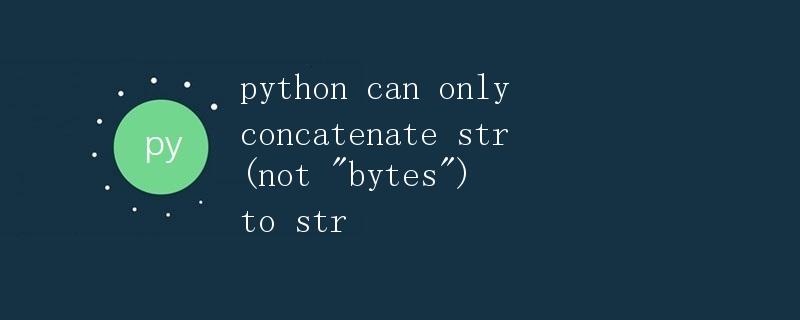Python中的str和bytes类型

在Python中,我们经常会遇到str和bytes这两种数据类型。str代表字符串,使用Unicode编码,而bytes代表字节串,是原始的字节序列。在处理字符串和字节串时,经常会遇到TypeError: can only concatenate str (not "bytes") to str这样的错误。
本文将详细介绍str和bytes类型的区别、相互转换的方法,以及解决TypeError: can only concatenate str (not "bytes") to str错误的方法。
str和bytes的区别
在Python 2中,str类型表示原始的字节串,unicode类型表示Unicode字符串。而在Python 3中,将str类型表示为Unicode字符串,另外引入了bytes类型。
str和bytes的主要区别在于:
str是Unicode字符串,使用str类型来表示文本数据;bytes是字节序列,用于表示原始的字节数据。
当我们需要处理文本数据时,应该使用str类型;当我们需要处理原始的二进制数据时,应该使用bytes类型。
str和bytes之间的转换方法
在Python中,我们可以使用encode()和decode()方法实现str和bytes之间的转换。
str转换为bytes
使用encode()方法可以将str转换为bytes,需要指定编码格式。
# str转换为bytes
s = "hello"
b = s.encode('utf-8')
print(b)
运行结果:
b'hello'
bytes转换为str
使用decode()方法可以将bytes转换为str,同样需要指定编码格式。
# bytes转换为str
b = b'hello'
s = b.decode('utf-8')
print(s)
运行结果:
hello
解决TypeError: can only concatenate str (not "bytes") to str错误
当我们在处理字符串和字节串时,有时会遇到TypeError: can only concatenate str (not "bytes") to str这样的错误。这是因为Python不允许将bytes类型和str类型进行直接连接操作。
解决这个问题的方法是将bytes类型转换为str类型或将str类型转换为bytes类型,然后进行连接操作。
将bytes转换为str类型
b = b'hello'
s = b.decode('utf-8')
result = s + " world"
print(result)
运行结果:
hello world
将str转换为bytes类型
s = "hello"
b = s.encode('utf-8')
result = b + b' world'
print(result)
运行结果:
b'hello world'
通过上述方法,我们可以避免TypeError: can only concatenate str (not "bytes") to str错误,顺利进行字符串和字节串的连接操作。
总结
str和bytes是Python中常用的数据类型,分别用于表示Unicode字符串和字节序列。在处理字符串和字节串时,需要注意它们之间的差别,以及通过encode()和decode()方法进行相互转换。
当遇到TypeError: can only concatenate str (not "bytes") to str错误时,可以通过将bytes转换为str或将str转换为bytes,来解决这个问题。
 极客笔记
极客笔记